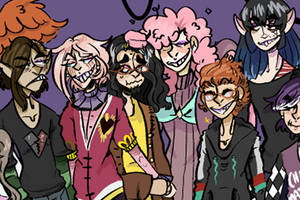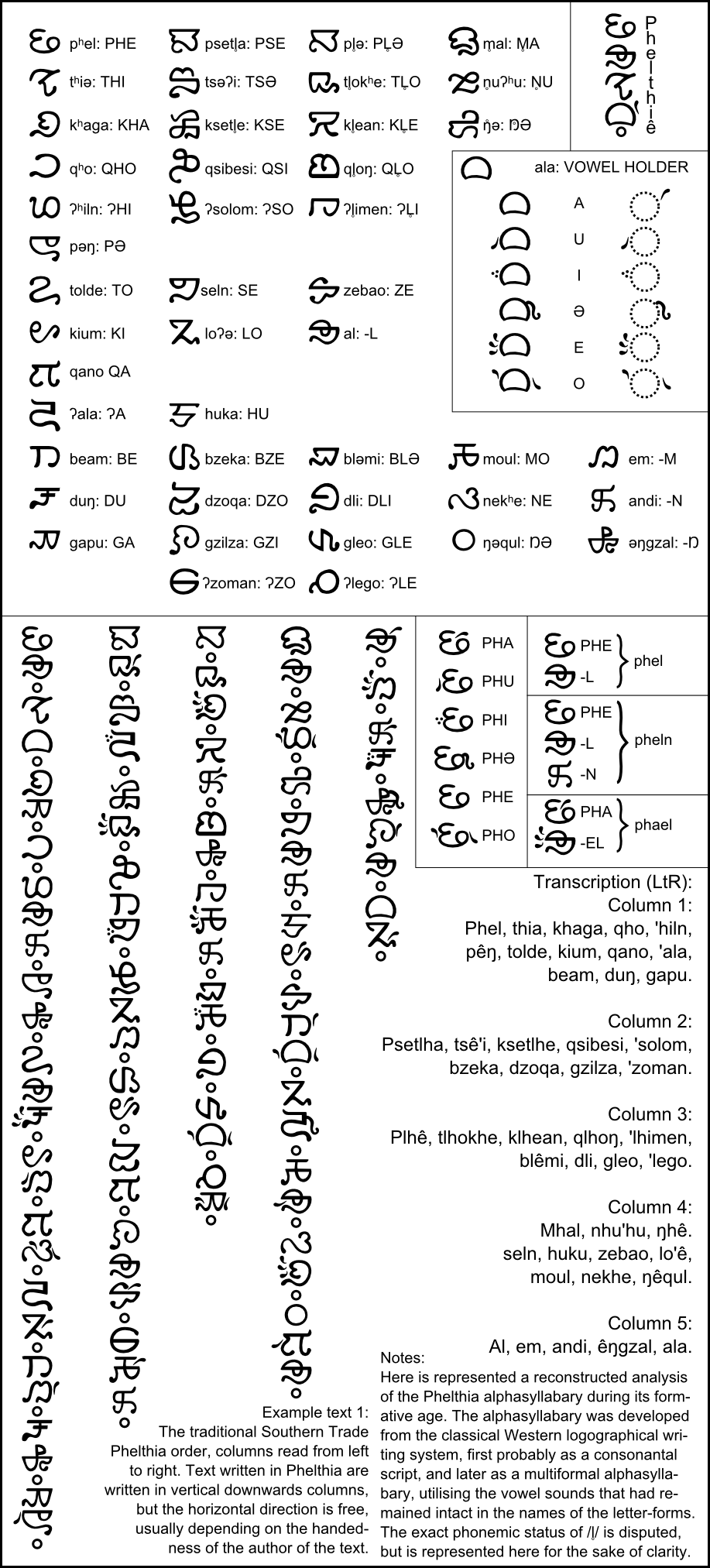ShopDreamUp AI ArtDreamUp
Deviation Actions

Exclusive Content
Starting now, I'll be posting some special exclusive posts that people can view for a small fee. Everything here will be SFW! This can include tutorials, hidden literature and artworks.
$5/month
Suggested Deviants
Suggested Collections
You Might Like…
Featured in Groups
Description
An abugida I made in a couple of days for the.. Story-I'm-Currently-Writing Verse. Probably the best name is Ysi.
This script is an abugida, [link] or alphasyllabary. [link]
It is a very early second-generation writing system, either directly descended from a logographic [link] script, or from an abjad [link] or consonantal alphabet [link] that is descended from that early logographic script.
Abugidas are alphabets that are based on the idea that each grapheme has an inherent vowel, and that by writing that letter, you write a simple syllable, instead of just the consonant it represents. Thus, the letter P, without any modification, would be read as PA.
Most abugidas' inherent vowels are uniform, in that each consonant takes the same inherent vowel. In scripts based on scripts used to write Sanskrit, this is 'a', which was the most common vowel in Sanskrit by far, because many of the other vowels were reduced in Indic languages to, iirc, schwa, which was represented by 'a'. In other abugidas, the inherent vowels can be different, but these are usually systematic in that a certain group of consonants takes a certain vowel, &c. To write another vowel other than the inherent one, you add a diacritic to the consonant letter. Many abugidas (most?) also have separate letters for the vowels in syllables with an onset consonant.
The Brahmic scripts, which has been the main-inspiration for Phelthiê, were third generation writing systems based on Aramaic consonantal alphabets (which was an abjad of the Middle East descended from Phoenician, like the Hebrew script and Arabic script, etc.), and it was rather distant from the logographic writing that begot these abjads, that is, the Hieroglyphs.
Phelthiê is a second generation scripts, or a third generation script that is really close to the originating logographic script (unimaginatively named Classical Western Logographic script here). Thus, the consonant letters retained very strong names based on the reading of the original logographic characters, analogous to Aleph, Bet, Gimel and Alpha, Beta, Gamma, and so forth. Instead of using a uniform vowel for all the consonant letters, the Phelthiê script extended its historical base in the names of the logographs, and used the first vowel of the logograph's reading as the inherent vowel of the consonant letter.
Thanks for Cum Quesa for the idea, from whom I shamelessly stole it. He didn't come up with the backstory, though.
Otherwise, Phelthië is a pretty typical abugida. Vowels are shown by diacritics attached to the consonant letter, etc. etc. The phonotactics of the original language the script was written in was pretty simple: the maximal syllable is (C)(L/S)V(L)(N). It had aspiration and five places of articulation for plosives, plus voicing distinctions and, later on, voiceless nasals and a lateral fricative that developed from aspirated sonorants.
The version given here is an over-regular reconstruction. The names of the letters should be taken with an asterisk. Later languages have developed the script further.
I made a pretty preview picture, but you can't do that if you don't have to do that. > stoopid dA.
stoopid dA.
This script is an abugida, [link] or alphasyllabary. [link]
It is a very early second-generation writing system, either directly descended from a logographic [link] script, or from an abjad [link] or consonantal alphabet [link] that is descended from that early logographic script.
Abugidas are alphabets that are based on the idea that each grapheme has an inherent vowel, and that by writing that letter, you write a simple syllable, instead of just the consonant it represents. Thus, the letter P, without any modification, would be read as PA.
Most abugidas' inherent vowels are uniform, in that each consonant takes the same inherent vowel. In scripts based on scripts used to write Sanskrit, this is 'a', which was the most common vowel in Sanskrit by far, because many of the other vowels were reduced in Indic languages to, iirc, schwa, which was represented by 'a'. In other abugidas, the inherent vowels can be different, but these are usually systematic in that a certain group of consonants takes a certain vowel, &c. To write another vowel other than the inherent one, you add a diacritic to the consonant letter. Many abugidas (most?) also have separate letters for the vowels in syllables with an onset consonant.
The Brahmic scripts, which has been the main-inspiration for Phelthiê, were third generation writing systems based on Aramaic consonantal alphabets (which was an abjad of the Middle East descended from Phoenician, like the Hebrew script and Arabic script, etc.), and it was rather distant from the logographic writing that begot these abjads, that is, the Hieroglyphs.
Phelthiê is a second generation scripts, or a third generation script that is really close to the originating logographic script (unimaginatively named Classical Western Logographic script here). Thus, the consonant letters retained very strong names based on the reading of the original logographic characters, analogous to Aleph, Bet, Gimel and Alpha, Beta, Gamma, and so forth. Instead of using a uniform vowel for all the consonant letters, the Phelthiê script extended its historical base in the names of the logographs, and used the first vowel of the logograph's reading as the inherent vowel of the consonant letter.
Thanks for Cum Quesa for the idea, from whom I shamelessly stole it. He didn't come up with the backstory, though.
Otherwise, Phelthië is a pretty typical abugida. Vowels are shown by diacritics attached to the consonant letter, etc. etc. The phonotactics of the original language the script was written in was pretty simple: the maximal syllable is (C)(L/S)V(L)(N). It had aspiration and five places of articulation for plosives, plus voicing distinctions and, later on, voiceless nasals and a lateral fricative that developed from aspirated sonorants.
The version given here is an over-regular reconstruction. The names of the letters should be taken with an asterisk. Later languages have developed the script further.
I made a pretty preview picture, but you can't do that if you don't have to do that. >
Image size
917x2025px 205.85 KB
© 2008 - 2024 Naeddyr
Comments18
Join the community to add your comment. Already a deviant? Log In
Wow. Just, wow...
When I needed an 'unknown' language, I swallowed my pride and bought a weird font...
WIRS_5 The Heptonstall Horror Part_8 Image
When I needed an 'unknown' language, I swallowed my pride and bought a weird font...
WIRS_5 The Heptonstall Horror Part_8 Image






























